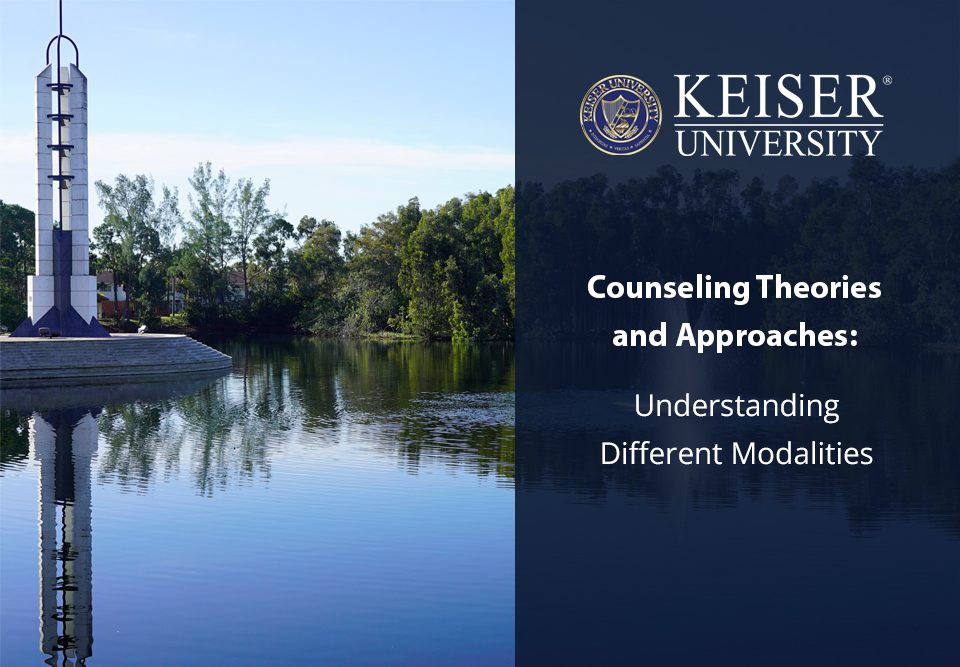Counseling is a uniquely diverse field in which no two professionals share the exact same mindset or approach. Yes, counselors draw on a similar body of knowledge, but like their clients, they are shaped by their experiences and their perceptions of those experiences. Known as the counseling theoretical foundation, this distinct fusion of personality, theory and practice equips counselors to serve clients from all walks of life.
Counseling theories are grounded in psychology and lay the foundation for effective counseling. These theories must be explored and understood as a crucial component when preparing for a career in counseling. In this guide, we will highlight several counseling theories.
What Are The Theories Of Counseling?
Counseling theories function as research-backed models of understanding, which grant counselors greater insight into the challenges their clients face. They also help determine the interventions most likely to deliver positive outcomes based on clients’ unique needs and circumstances.
Definition of Counseling Theory
Counseling theories examine how clinicians perceive of — and strive to shape — clients’ behaviors. In the resource Theories of Counseling and Psychotherapy, Robert Rocco Cottone, Ph.D. provides a well-rounded definition, explaining that the counseling theory forms an “intellectual model that purports certain ideas about underlying factors that affect behavior, thoughts, emotions, interpersonal interactions, or interpersonal interpretations.”
Cottone adds that, while counseling forms the process through which clinicians aim to influence clients’ behaviors, the counseling theories that underscore this practice provide a focus of study while also revealing how various techniques are likely to affect clients.
Importance of Understanding Various Theoretical Approaches
Different models or techniques may be applicable in different situations, so it is important for counselors to develop a well-versed understanding of the profession’s theoretical frameworks and modalities.
These theories can then help counselors develop what Cottone refers to as paradigms: vast “theory-encompassing model[s]” that are “based on different professional, political, and philosophical positions related to the nature of the psychotherapeutic enterprise.”
Paradigms form the big picture for how counselors address their day-to-day work. This brings context to their role and can help them better understand the focus of their treatment initiatives. Theoretical variations may exist within these paradigms. However, by understanding the full scope of relevant theories, counselors can develop the most relevant and impactful paradigms that positively influence how they relate to clients.
What Is The Psychodynamic Approach In Counselling?
Originating from the notorious Sigmund Freud, psychodynamic therapy (PDT) reveals how unconscious processes can play out in clients’ present thoughts, emotions and behavior. Typically centered around talk therapy, this approach strives to improve client self-awareness.
Principles and Techniques of Psychodynamic Therapy
Developed as an alternative to psychoanalysis, PDT functions as a less time-intensive option. This is when clients quickly come to understand the foundation of their emotional distress while engaging in self-reflection. Core principles and techniques include:
Expressing emotions. A number of clients struggle to translate their overwhelming emotions into words. Techniques such as transference (redirecting feelings) and open-ended questions help clients express themselves, rather than rely on avoidance or other unhelpful coping mechanisms.
Identifying patterns. PDT may reveal self-defeating patterns or other themes that might otherwise not be evident to clients. This approach may also highlight relationship patterns and how they play into ongoing emotions or behaviors.
Freudian Concepts and the Unconscious Mind
Psychodynamic therapy is underscored by Freudian concepts such as the unconscious mind. This refers to the ideas or impulses that have been repressed. Meanwhile, conscious thoughts form the tip of the mental and emotional iceberg. Freudian theory posits that, upon understanding the unconscious, clients can be relieved of acute psychological distress.
Transference and Interpretation in Therapy
Transference can be a valuable strategy for helping clients express their feelings. This occurs when feelings related to past experiences are projected onto individuals influential in the present, which is often the therapist or counselor.
While this can potentially prove disruptive, Freud argues that transference is a necessary part of the therapeutic process. Freudian theory suggests that with appropriate guidance, transference can help shift memories from the unconscious to the conscious.
What Is The Humanistic Approach In Counselling?
Humanistic counseling offers a holistic approach, emphasizing the whole person, especially the positive traits that influence growth and healing. Rather than delving into past events, humanism focuses on what clients can do in the here and now.
Understanding the Core Principles of Humanistic Therapy
Humanism centers around self-discovery but provides an empathetic environment in which clients feel free to explore. Core components include:
Empathy. Success in humanistic therapy relies on “unconditional positive regard,” in which clinicians maintain a compassionate and non-judgmental approach to help clients feel valued and empowered.
Accountability. Humanistic therapy grants clients an active role in shaping their treatment. In return, clinicians maintain high expectations. This conveys a higher level of respect for clients and is believed to help clients take charge of their own lives.
Person-Centered Therapy
Developed by the highly influential Carl Rogers, person-centered therapy suggests clients can reach their full potential. Those counseling processes should therefore be centered around (and, to a large degree, directed by) clients.
Carl Rogers’ Client-Centered Approach
While treating people with emotional disorders, psychologist and humanist Carl Rogers believed that his patients suffered primarily because they held negative and often inaccurate feelings about themselves. Furthermore, he believed that people with a positive sense of self were better equipped to deal with life’s challenges. Through his client-centered approach, he aimed to reveal that clients could rely on their own strengths.
Utilizing Empathy and Genuineness
Empathy is a cornerstone of humanism. This typically takes the form of active listening, in which clinicians pay attention to the thoughts and feelings of their clients without expressing judgment. Paraphrasing or summarizing can help clients better understand their feelings.
Congruence (or genuineness) is also important. Counselors should not ”hide behind a professional facade,” but rather, should strive for a transparent approach. This consists of relating to their clients without deceiving them. That approach helps clients develop trust not only in their counselors, but also in themselves.
What Is The Cognitive Behavioral Approach In Counseling?
As one of today’s most trusted and commonly utilized therapeutic modalities, cognitive behavioral therapy (CBT) focuses on changing harmful thought patterns. This possesses the intention of ultimately driving positive behavioral changes.
Examining the Cognitive-Behavioral Model
Pioneered by Aaron Beck, CBT provides a deep dive into the complex relationships between thoughts, feelings and behaviors. The cognitive-behavioral model describes how these are linked and how they play into the onset of various psychological disorders. This model also highlights a few main thought processes:
- Overgeneralized and rigid core beliefs.
- Influential, but often hidden automatic thoughts.
- Currently relevant assumptions are known as intermediate beliefs.
- H3: Cognitive Restructuring Techniques
Cognitive restructuring is a powerful technique that promises to reshape clients’ thought processes. This begins with the identification of cognitive distortions. Once these are fully understood, clients can take steps to correct these maladaptive thinking patterns and hopefully, limit negative self-statements.
While cognitive restructuring can draw on multiple processes, APA guidance highlights a step-by-step solution in which clients summarize upsetting situations. From there, they identify the most upsetting feelings experienced during those situations and identify the thoughts that underscore upsetting feelings.
What Are Behavioral Interventions In Counseling?
CBT blends aspects of cognitive and behavioral therapeutic strategies to achieve a diverse approach to addressing problematic behaviors or thought processes. Behavioral interventions encourage clients to take action to reduce unwanted behaviors while also developing coping mechanisms or focusing on healthy or positive behaviors. Depending on the client and the circumstances, this could involve calming strategies or role-playing to prepare for difficult situations that might arise in the future.
Exposure Therapy and Systematic Desensitization
Exposure therapy encourages clients to face their fears instead of avoiding them. Through systematic desensitization, clients discover for themselves that their fears can be managed. This may involve deep relaxation strategies, which are designed to produce reciprocal inhibition by counterconditioning to replace undesired responses with better alternatives. Systematic desensitization may also require creating fear hierarchies and employing a step-by-step process of working through a fear scale.
What Is The Existential Counseling Approach?
Existential therapy stands in stark contrast to plenty of conventional therapeutic modalities, but that’s exactly what makes it appealing to some clients. This unique approach takes a closer look at the inherent conflicts of the human experience, including collective anxieties regarding isolation and death.
As SAMSHA resources explain, the existential counselor is “interested in helping the client find philosophical meaning in the face of anxiety by choosing to think and act authentically and responsibly.”
Themes of Meaninglessness, Freedom and Mortality
According to existential theory, humans are responsible for creating their own sense of meaning. Existential therapy also posits that mortality plays a critical role in driving this sense of meaning. When people accept these difficult realities, they find the freedom to shape their lives, which can ultimately prove empowering.
Techniques for Helping Clients Confront Dilemmas and Find Purpose
While existential therapy represents a uniquely philosophical approach, a few key techniques allow clients to find the acceptance and the autonomy that this modality promotes. Numerous clients benefit greatly from mapping their worldview, including core assumptions about themselves and their communities. In the interim, role-playing can help clients determine what they regard as a meaningful life.
What Are The Three Approaches To Existential Counseling?
Existential counseling can be understood through three primary approaches: Daseinsanalysis, Logotherapy, and Existential-Humanistic Therapy. While each offers a distinct framework for addressing fundamental concerns like freedom, meaning, isolation, and death, they share a commitment to helping clients pursue authentic living.
These approaches are not rigid categories. In practice, therapists may integrate strategies across them to best address individual needs and circumstances. For some clients, this might involve focusing on meaning and purpose, while for others the emphasis may be on self-awareness, relationships, or acceptance of mortality. Regardless of the method, the overarching goal is to support clients in their journey of self-discovery, personal responsibility, and self-growth.
Daseinsanalysis
Rooted in the philosophy of Martin Heidegger, Daseinsanalysis emphasizes “being-in-the-world,” highlighting the inseparable link between individuals and their environments. This approach helps clients examine their lived experience within a broader social context, encouraging them to reflect on how relationships, culture, and community shape their sense of self.
Rather than pathologizing symptoms, Daseinsanalysis focuses on understanding the meaning behind struggles such as anxiety or despair. Counselors working within this framework guide clients to recognize how avoidance, fear, or limited perspectives may disrupt emotional regulation and restrict authentic living. By bringing attention to these dynamics, clients can confront existential concerns and find opportunities to live more deliberately.
Logotherapy (or Meaning-Centered Therapies)
Developed by Viktor Frankl, Logotherapy is based on the belief that the search for meaning is the primary human drive. This approach encourages clients to uncover purpose even in difficult circumstances, framing challenges as opportunities for growth rather than insurmountable obstacles.
Meaning-centered therapies are often applied when clients struggle with existential crises or feelings of emptiness. Through a focus on meaning, counselors help clients reframe their experience and find direction, which can be especially helpful for those managing anxiety or depression. Rather than concentrating only on symptom relief, Logotherapy empowers individuals to connect with deeper values and commitments that guide authentic living.
Existential-Humanistic Therapy
Existential-Humanistic Therapy combines the philosophical focus of existentialism with the person-centered principles of humanism. This approach emphasizes authentic connection, empathy, and the client’s capacity for growth, while also recognizing the universal challenges of freedom, isolation, and mortality.
Counselors using this framework explore how clients’ thought patterns and learned behaviors may either support or hinder authentic living. When clients rely on maladaptive behaviors to cope with uncertainty or fear, therapy provides a space to examine those patterns with compassion and curiosity. The process encourages individuals to cultivate self-awareness, embrace responsibility, and create a more meaningful life aligned with their values.
What Is The Integrative Counseling Approach?
Offering a holistic approach, integrative counseling combines techniques from various therapeutic schools of thought. The goal here is to determine which blend of strategies best fits each client’s unique personality and experiences. This can be appealing to clients not adequately served by any one modality. It is especially valuable when clients want to have a greater say in the therapeutic process, particularly if they view their relationship with the counselor as a partnership.
Integrative Therapy and Combination of Multiple Theoretical Frameworks
Integrative counseling calls for an in-depth understanding of several theoretical frameworks. Counselors must also take the time to understand the forces that shape their clients’ thoughts and behaviors, including their needs, preferences, openness and health, to name a few.
From there, counselors can draw not only on the modalities highlighted above, but also on options such as meditation, music therapy, dialectical behavior therapy or trauma-informed care.
Benefits and Challenges of Integrating Counseling Modalities
While a myriad of clients benefit greatly from the targeted nature of integrative counseling, there are distinct challenges to consider. The chief among these is the potential loss of focus or clarity as counselors draw from too many modalities. Critics allege that counselors who rely too heavily on integrative strategies may never develop sufficient expertise in any one approach.
Advocates believe that the patient-centric nature of this approach is more empowering, and therefore, better suited to those with co-morbidities or other challenges that may be difficult to overcome when relying on just one modality.
Exploring Powerful Counseling Theories With Keiser University
Whether you are inspired by one of the core counseling theories or interested in combining several approaches, Keiser University offers graduate programs designed to help you grow both personally and professionally. The Master of Science in Clinical Mental Health Counseling equips students to support clients with diverse individual needs, from managing depression to strengthening emotional regulation.
For those drawn to holistic care, the Master of Science in Psychology or the Master of Science in Occupational Therapy emphasizes improving well-being in daily life. Scholars seeking advanced research opportunities may pursue the Doctor of Philosophy in Psychology, where they can explore complex thought patterns and contribute to the future of the field. Together, these programs reflect Keiser University’s commitment to preparing graduates who are ready to meet challenges with knowledge, compassion, and purpose.
Connect with a graduate admissions counselor today to find the program that aligns with your goals for meaningful impact and lifelong self-growth.






 The instructors at Keiser University impacted my life. They believed in my ability to become a great graphic designer, regardless of how I felt about my skills. KU helped to prepare me for the real world and got me to where I am today.
The instructors at Keiser University impacted my life. They believed in my ability to become a great graphic designer, regardless of how I felt about my skills. KU helped to prepare me for the real world and got me to where I am today.
